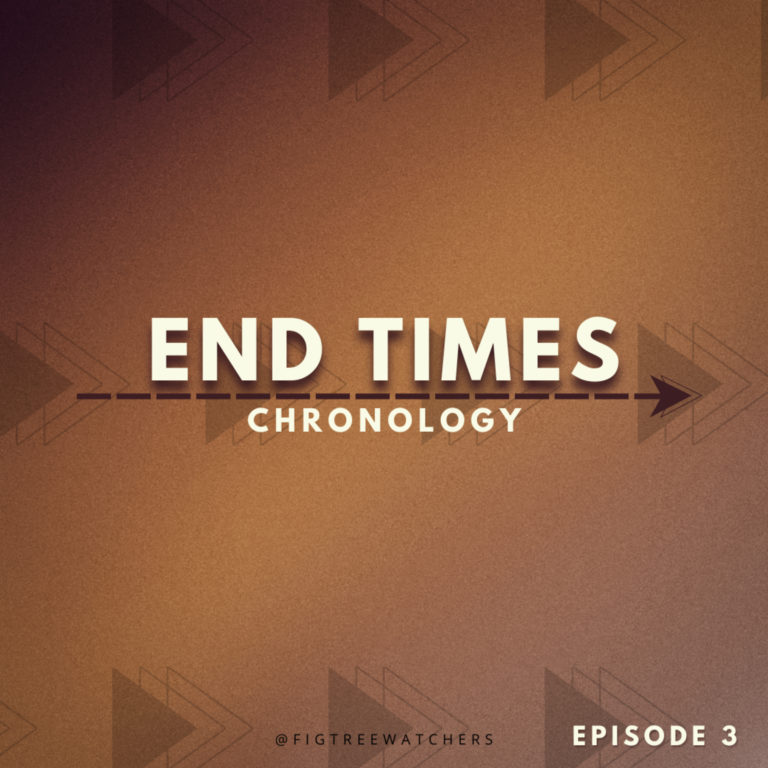
To share the Gospel, through the expository teaching of Scripture. Creating disciples-of Christ. Encouraging others to love God and others.
Website: www.figtreewatchers.com
Instagram: https://www.instagram.com/figtreewatchers/
Facebook: https://www.facebook.com/figtreewatchers/
Telegram: https://t.me/figtreewatchers
In this episode we began taking a look at the different views on the millennium: amillennialism, postmillennialism, and premillennialism and began making a case for the premillennial viewpoint.
Co-Hosted by Ayomikun Shosanya & Stephan Caraway.
Navigate to the links below to access the show notes for this episode which contains links to the stories we went over as well as articles, social media accounts, and other resources. If you enjoyed this episode, and are blessed by the ministry, we’d greatly appreciate it if you left a rating and a review.
Episode 135
Episode notes:
https://www.figtreewatchers.com/figtreewatchers-podcast-episode-135-end-times-chronology-the-millennium-part-1/
Website: www.figtreewatchers.com
Instagram: https://www.instagram.com/figtreewatchers/
Facebook: https://www.facebook.com/figtreewatchers/
Telegram: https://t.me/figtreewatchers
Email: [email protected]

In this episode we began taking a look at the different views on the millennium: amillennialism, postmillennialism, and premillennialism and began making a case for the premillennial viewpoint. For a downloadable version of the show notes, click download below.
Amillennialism
The millennial kingdom is not a literal 1,000 year reign of Christ on the earth. Those who adhere to this view believe that it began at Christ’s resurrection and is manifest either in the hearts of saints in heaven or saints on earth. They also believe that instead of Christ reigning here on earth, he is now seated on the throne of David with the church age being the kingdom that he’s reigning over.
According to Blue Letter Bible’s Four Views on the Millennium, “the amillennialist believes that the Kingdom of God was inaugurated at Christ’s resurrection…at which point he gained victory over both Satan and the Curse. Christ is even now reigning…at the right hand of the Father over His church. After this present age has ended, Christ will return and immediately usher the church into their eternal state after judging the wicked. The term “amillennialism” is actually a misnomer for it implies that Revelation 20:1-6 is ignored; in fact, the amillennialist’s hermeneutic interprets it (and in fact, much of apocalyptic literature) non-literally.” The prefix “a” in the name “amillennialism” means “no” or “not”. Therefore the name means “no millennium”. (Four Views on the Millennium)
Amillennialism is described by Floyd E. Hamilton as a view “that Christ’s millennial kingdom extends from His Resurrection from the tomb to the time of His Second Coming on the clouds at the end of this age”.1
Postmillennialism
The “millennium is an era (not a literal thousand years) during which Christ will reign over the earth, not from an literal and earthly throne, but through the gradual increase of the Gospel and its power to change lives. After this gradual Christianization of the world, Christ will return and immediately usher the church into their eternal state after judging the wicked,” (Four Views on the Millennium).
This view is called postmillennialism because it places the return of Christ after the millennium.
Premillennialism
The millennial kingdom is a literal 1,000 year reign of Christ here on the earth. Those who adhere to this view believe that Jesus will come back after the tribulation and set up a literal 1,000 year kingdom on earth in which we will reign with him here on earth.
This view is called premillennialism because it places the return of Christ before the millennium. Note that it’s also within the premillennial view where we see the various rapture views. Although they differ in timing in respect to the tribulation, they are all within the premillennial framework.
Within the premill view there are varying views on the rapture:
- Pretrib: The pre-trib rapture occurs before the start of the tribulation. The pre-trib view is the only one of the 4 that states we will not go through the tribulation.
- Mid-Trib: The mid-trib rapture occurs at the half-way (3.5 year) mark of the tribulation. In this view, Christians experience only the first half of the tribulation and are taken out before the 2nd half starts.
- Pre-wrath: The pre-wrath view is the position that we will go through the seal and trumpet judgments but will be taken out of the tribulation before God pours his 7 bowl judgments on the earth.
- Post-trib: The post-trib rapture occurs at the end of the 7 year tribulation. It’s the only one that states we will go through the full 7 years of tribulation. Those that adhere to this view commonly use Matthew 24:29-31 as a basis that after the tribulation Jesus will return and gather us to Himself.
Problems with the Views – Amillennialism
“On earth, Christ’s kingdom ‘is not of this world,’ but He reigns esp. in the hearts of His people on earth, . . . for a ‘thousand years,’ the perfect, complete time between the two comings of Christ.”1
So this implies that following the second coming of Jesus, there will be only one resurrection of the dead and one judgment.
The first example we’ll focus on is the resurrection of the dead. Amillennialists universally agree that there is one resurrection of the dead. One scholar, Geerhardus Vos, makes this statement, “The New Testament confines the event of the resurrection to a single epoch, and nowhere teaches, as chiliasm assumes, a resurrection in two stages, one, at the parousia, of saints or martyrs, and a second one at the close of the millennium. Although the doctrine of a temporary Messianic kingdom, preceding the consummation of the world, is of pre-Christian Jewish origin, it had not been developed in Judaism to the extent of assuming a repeated resurrection; the entire resurrection is always placed at the end.2
Scripture actually indicates the opposite. Daniel prophesied about his resurrection at the end of the Tribulation, ““At that time Michael shall stand up, The great prince who stands watch over the sons of your people; And there shall be a time of trouble, Such as never was since there was a nation, Even to that time. And at that time your people shall be delivered, Every one who is found written in the book. And many of those who sleep in the dust of the earth shall awake, Some to everlasting life, Some to shame and everlasting contempt.” (Daniel 12:1-2, NKJV)
Then this scripture: “And I saw thrones, and they sat on them, and judgment was committed to them. Then I saw the souls of those who had been beheaded for their witness to Jesus and for the word of God, who had not worshiped the beast or his image, and had not received his mark on their foreheads or on their hands. And they lived and reigned with Christ for a thousand years. But the rest of the dead did not live again until the thousand years were finished. This is the first resurrection.” (Revelation 20:4-5, NKJV)
“Another hurdle that anti-millennialists needed to overcome was that Revelation 20:4-6 speaks of multiple resurrections. This cannot be if anti-millennialism was to gain a foothold. It was the Donatist theologian, Tyconius, who suggested an allegorical interpretation of Revelation 20.26 Augustine adopted Tyconius’ interpretation of Revelation 20 and produced the earliest form of amillennial theology. Thus, Augustine, in Book XX of The City of God, was the first to actually spell-out a positive statement of amillennialism, which at the same time produced some incipient principles upon which postmillennialism would later arise.”3
Sources
- Four Views on the Millennium (Blue Letter Bible)
- ‘R. Fowler White, “On the Hermeneutics and Interpretation of Rev 20:l-3: A Preconsummationist Perspective,” JETS 42/1 (March 1999):53.
- A Rapture Study
- Saturday Apologetics (12-4-21): The Millennium Part 1
- Saturday Apologetics (12-18-21): The Millennium Part 2
- https://digitalcommons.liberty.edu/cgi/viewcontent.cgi?article=1053&context=pretrib_arch
Social Media & Sharing
If you were blessed by our content follow us on Instagram, Facebook, or Telegram. Subscribe to our podcast wherever you listen to podcasts and please give us a rating and a review. It would be very helpful and greatly appreciated.
Also, our passion is to answer any questions you may have regarding bible prophecy and current events. To that end, we encourage you to submit questions you have or send us a topic idea that you’d like to see get covered.
All requests and/or questions can be emailed to [email protected] or you can send us a DM on our social media pages. We look forward to hearing from you soon.
The Gospel Presentation
Revelation 19:10 tells us that the essence of bible prophecy is Jesus Christ. These things were revealed to us so that we ultimately believe in Christ (John 13:19). We’ve all sinned and fallen short of the glory of God (Psalm 51:5, Romans 3:23). Because God is Holy he must judge sin. The penalty of this sin is death and ultimately the Lake of fire (Romans 6:23, Revelation 20:11-15). There’s nothing we can do to save ourselves (Isaiah 64:6).
But God, in his love has provided a way to escape his wrath through Christ (John 3:16-18, John 14:6). Jesus paid for our sin penalty by taking God’s wrath in our stead on the cross (Romans 5:8). He died for our sins, was buried, and rose again 3 days later (1 Corinthians 15:1-5).
You can accept this free gift of salvation by believing in Christ (Acts 16:30-31, Romans 6:23, Ephesians 2:8-9). Make sure you’ve made the right decision about Jesus today (2 Corinthians 6:2)! It will be the most important decision of your life, for eternal life.
- Floyd E. Hamilton, s.v. “Amillennialism” in The Zondervan Pictorial Encyclopedia of the Bible, Vol. 1, p. 129. [↩] [↩]
- Eschatology of the New Testament, Geerhardus Vos. https://www.monergism.com/eschatology-new-testament-ebook [↩]
- May 2009,The Unscriptural Theologies of Amillennialism and Postmillennialism, Thomas D. Ice [↩]

